The eighth Stalinist strike: the battle for the Baltics
In addition, we must not forget that the Baltic nationalists supplied the Germans with "cannon fodder". They were particularly active in the police and punitive divisions, freeing the divisions necessary for the Germans on the front lines. It is worth recalling the fact that the Baltic was considered the "living space" of the Third Reich. The region was planned to be settled by the Germans, and the “inferior population” (including Lithuanians, Latvians and Estonians) was planned to be evicted deep into Russia, leaving part of them as attendants, slaves.
Therefore, for Berlin it was very important to retain the Baltics. The loss of this region was a significant blow to the German Empire. East Prussia was under attack. The Baltic Fleet received freedom of action. Germany was losing an important economic base. The German command did not want to withdraw Army Group North from the Baltic States, and it was already difficult to carry out such evacuation during this period.
Offensive operations in the Baltic States have become so-called. "The eighth Stalinist blow". The Baltic strategic offensive operation was carried out from 14 September to 24 in November 1944. Its main goal was to defeat the German troops in the Baltic States and liberate Estonia, Latvia and Lithuania. The battle for the Baltic states included four front-line and inter-front operations: Riga, Tallinn, Moonsund and Memel. The battle lasted 71 day, the width of the front reached 1000 km, and the depth - 400 km. The Baltic operation ended with the defeat of the German army group "North", the formation of the Courland boiler and the liberation of the three Baltic republics from the German occupation.
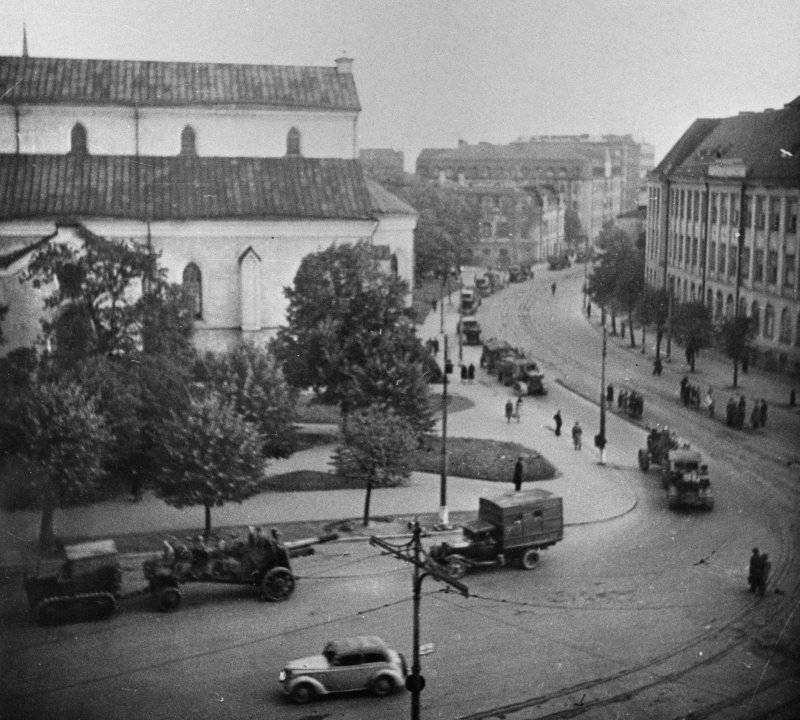
Column of Soviet 152-mm howitzers ML-20 in liberated Tallinn
prehistory
A major offensive in the Baltic States began to be prepared at the height of the Belarusian operation (Fifth Stalinist strike: operation "Bagration"). Until the summer of 1944, a major offensive operation in the Baltic States did not have favorable conditions. In the summer of the year 1944 on the Baltic direction, Soviet troops conducted a series of operations that led to the liberation of important territories and the deterioration of the position of the German army. Participating in the Belarusian operation, at the beginning of July, the 3 of the Belarusian Front crossed the border of the Lithuanian SSR and on July 1944 in July, liberated Vilnius. In the future, Soviet troops reached the Lithuanian border with East Prussia.
5 — 31 July 1944, the troops of the 1 of the Baltic Front commanded by Ivan Baghramian carried out the Šiauliai operation (it was part of the strategic Belarusian operation). As a result, the Soviet troops defeated the Siauliai grouping of the enemy, liberated significant territories of Latvia and Lithuania. 30-31 July Soviet troops liberated Tukums and Jelgava, reached the Gulf of Riga. The German Army Group North was temporarily cut off from East Prussia. In August, during the heavy fighting, the Germans were able to restore the land connection of the Baltic States with East Prussia.
10 — 27 July 1944. The troops of the 2 of the Baltic Front, led by Andrei Eremenko, conducted the Rezhitsko-Dvinskuyu operation. As a result, the Soviet troops broke through the five strong defensive lines of the enemy, advanced on 190 — 200 km, liberated 7 of large and 16 small towns, the entire 5261 settlement. Among them are such important centers as Idritsa, Drissa, Opochka, Sebezh, Rezekne (Rezhitsa) and Daugavpils (Dvinsk). The liberation of the Kalinin region was completed and the liberation of Latvia began. In addition, the northern flank of the Soviet offensive in Belarus was secured. Significant German formations were shackled by the battle, and they could not be transferred to Belarus. The German command had to transfer troops from the front to the front (first to Belorussia, then to the Baltic states), as a result, they did not have anywhere. The German divisions, exhausted by marches and battles, could not keep even strong and advance equipment defensive lines.
11-31 July 1944. The troops of the 3 Baltic Front under the command of Ivan Maslennikov conducted the Pskov-Ostrovsky operation. The well-prepared enemy defense (Panther line), which was defended by the troops of the 18 Army, was broken. Soviet troops occupied the powerful Pskov-Ostrovsky fortified area, liberated the Island and the ancient Russian city of Pskov. The operation led to the final liberation of the Leningrad Region, and contributed to the offensive of the neighboring Leningrad Front.
24 — 30 July 1944. The troops of the Leningrad Front, commanded by Leonid Govorov, with the support of the Baltic Fleet, conducted the Narva operation. As a result, the Narva group of the Wehrmacht was defeated. Soviet soldiers liberated the city and the fortress of Narva. The Narva bridgehead was significantly expanded, which improved the operational position of the Soviet troops before the strategic Baltic operation. The liberation of Narva contributed to the successful offensive of the 3 of the Baltic Front on the Tartu axis.
1 - 28 August 1944. The troops of the 2 Baltic Front under the command of Andrei Eremenko conducted the Luban-Madona operation. The Soviet troops with heavy fighting overcame the impassable wooded and swampy Luban lowland, reflecting strong enemy counterattacks. The cities of Lebanon, Varaklany, Barkava, Ligatne, Krustpils and other settlements were liberated. By storm they took a powerful knot of resistance to the city of Madona. The Germans failed to stop the Soviet offensive, but were able to significantly slow down its pace and, as a result, exhaust the advancing Soviet forces. However, the Eremenko troops were able to reach the starting line for a strike on Riga, albeit with a strong delay.
10 August - 6 September, the troops of the 3 of the Baltic Front held a Tartu operation. As a result, Soviet troops advanced on 100 - 130 km, liberated the city of Tartu and defeated the enemy’s Tartu grouping. Conditions were created for entering the shores of the Gulf of Riga and striking the flank and rear of Narva’s enemy force.
Thus, in the summer of 1944, most of the defense lines of the Wehrmacht in the Baltic States collapsed, the Soviet troops in some areas advanced more than 200 km. Almost half of the Baltic territory was liberated from the Nazis. Soviet operations allowed to tie up significant forces in the Baltic direction, which contributed to the forces of the Belarusian Front to complete the defeat of the Army Group Center in Belarus and break through into Eastern Poland. Soviet troops reached the outskirts of Riga, creating all the conditions for the completion of the liberation of the Baltic states.
Offensive plan
According to the directives of the Headquarters of the Supreme Command, it was envisaged that the troops of the three Baltic fronts and the Leningrad Front, with the support of the Baltic Fleet, dismember and destroy Army Group North, and finally liberate the Baltic states. The troops of the Baltic fronts delivered converging strikes in the direction of Riga. The Leningrad Front was advancing in the Tallinn direction. The main strike was considered to be in the Riga direction, where the main forces of the German 16th and 18th armies held the defense. There were five tank divisions of the Wehrmacht. This blow was supposed to lead to the defeat of the main forces of the "North" group and the liberation of Riga - the most important political and industrial center, a junction of land and sea communications of the Baltic.
The destruction of the German task force Narva in Estonia was assigned to the troops of the Leningrad Front and the Baltic Fleet. Govorov’s troops were to strike from the Tartu region in the direction of Rakvere. Thus, the troops of the Leningrad Front were to go behind the enemy’s Narva group, encircle and destroy it. At the second stage, the front troops were supposed to liberate the capital of Estonia - Tallinn, to reach the eastern coast of the Baltic Sea. The Baltic Fleet under the command of Admiral Vladimir Tributs was given the task of supporting the coastal flank of the Leningrad Front, preventing the landing of reinforcements and the evacuation of enemy forces by sea. Marine aviation received the task of bombing the enemy’s coastal rear.
The 3 Baltic Front delivered the brunt on its right flank (the 67 and 1 shock army) and in conjunction with the Baltic 2 front, which followed the Madona-Riga line, in order to crush the Riga enemy group and liberate the capital Of Latvia.
The 1 Baltic Front received the task of attacking the main forces along the left bank of the Zapadnaya Dvina in the Riga direction. Soviet troops had to go to the coast of the Gulf of Riga in the area of Riga, not allowing the main forces of the Army Group North to withdraw in the direction of East Prussia. A part of the forces of the 3 Belorussian Front, commanded by Ivan Chernyakhovsky, also participated in the operation. The troops of Chernyakhovsky were advancing in the western direction, with the aim of holding down the enemy forces in East Prussia by combat and not allowing them to maintain the corridor to the Baltic states. The general leadership of the operation and the coordination of the actions of the fronts were carried out by Marshal of the Soviet Union Alexander Vasilevsky.
The Baltic fronts were to launch the September 5-7 offensive, the Leningrad Front, the September 15. However, the preparation of a strategic operation faced a number of difficulties. There was not enough time, so the Headquarters postponed the start of the offensive in the Riga area for a week. The Leningrad Front was to launch the September 17 offensive. Thanks to this time, it was possible to better prepare for the offensive, to reconnoiter the positions of the enemy, to bring ammunition, fuel, and food. The sappers completed the construction of the planned roads and prepared to force water obstacles.
The forces of the parties
THE USSR. The forces of the left wing of the Leningrad, three Baltic, part of the 3-Byelorussian fronts consisted of about 900 thousand people, more than 3 thousand tanks and SAU, about 17,5 thousand guns and mortars, over 2,6 thousand aircraft. The operation involved 12 armies, that is, almost three-quarters of the strength of four Soviet fronts. The offensive also supported the ships and aircraft of the Baltic Fleet.
Germany. By early September, Army Group North, under the command of Ferdinand Schörner, included the 16 and 18 Army, the 3 Tank Army (20 of September was transferred from the Army Group Center) and the Narva Task Force. In total, they included about 730 thousand people, more than 1,2 thousand tanks and self-propelled guns, about 7 thousand guns and mortars, about 400 aircraft.
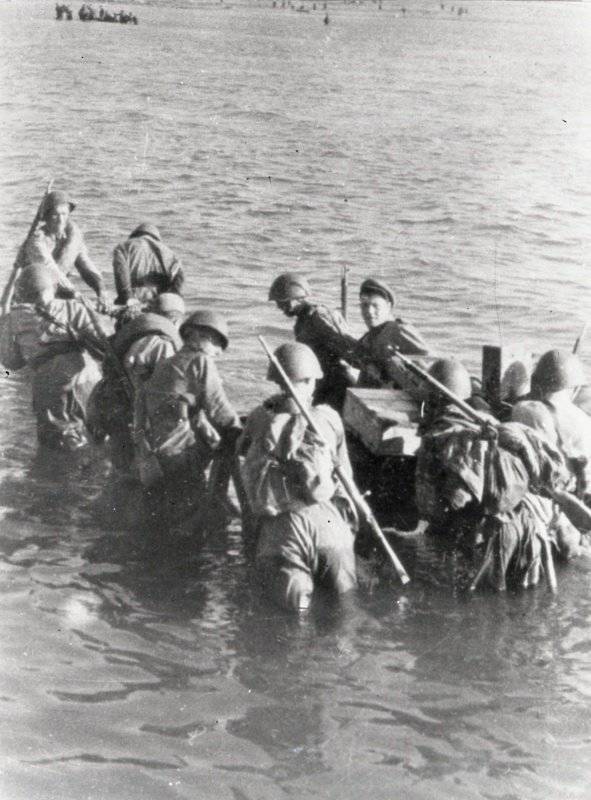
The landing of the Soviet troops on the island of Saaremaa (Ezel) in Moonsundskogo archipelago
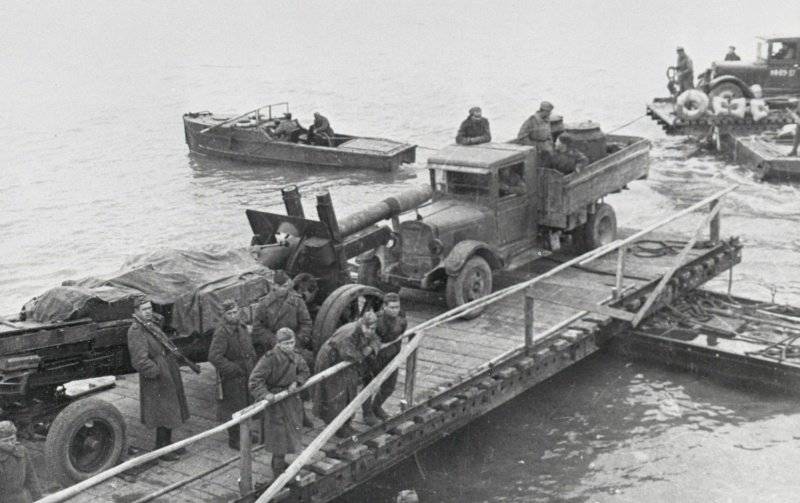
The transfer of Soviet heavy artillery to the island of Saaremaa
Events of the German command and defense system
The success of Operation Bagration dramatically worsened the position of Army Group North. German troops were deeply enveloped from the south and pressed to the sea. Above the German grouping in the Baltic States threatened to get into a huge "cauldron". On the other hand, the Baltic bridgehead allowed the Wehrmacht to inflict a flank attack on the Soviet troops. Therefore, to leave the Baltics considered inappropriate. In order to stabilize the front in the Baltic direction, the German command stepped up engineering work here, erecting additional defensive lines and facilities, and also deployed reinforcements.
In the direction of Riga was the strongest group, which included the 5 tank divisions. Riga fortified area was considered insurmountable for the Russians. On the approaches to the capital of Latvia from the north-east and east, four defensive lines were equipped.
A very powerful defense was in the Narva direction. The relatively narrow isthmus between the Gulf of Finland and Lake Peipsi allowed for a well-equipped line of defense to be created here. Soviet troops unsuccessfully stormed these positions during the Leningrad-Novgorod operation. Now they are further strengthened. In the Narva direction, the Germans had three defensive lines with a total depth of 25-30 kilometers.
Usually, the main line of the main defensive lines included two or three positions. In front of the positions, wire obstacles were organized and minefields with anti-personnel and anti-tank mines were installed. The positions themselves had two or three trenches connected by communications. Positions were located at a distance of several kilometers from each other. Between the main defensive lines created intermediate. In order to impede the actions of the ships of the Baltic Fleet, the Germans in the Gulf of Finland set up various obstacles. Both fairways along the southern and northern shores of the Gulf of Finland were closed by mines. Especially densely mined were the Narva Bay and the Tallinn Bay.
In August, several infantry and tank divisions, reinforcements, and a large number of vehicles were transferred from Germany and from the front sectors, which were considered “calm”. Infantry divisions, exsanguinated in previous battles, on average filled up to 8 thousand people. For this, they used personnel from air and sea fleets, as well as various rear units and institutions. Mobilized young and old men. To restore the combat capability of Army Group North, Germany spent a significant part of the human and material resources assigned to the armed forces.
At the same time, Army Group North retained a rather high fighting spirit. The troops maintained fierce discipline. To "support" the advanced units formed detachments from the SS troops. The propaganda machine continued to convince the soldiers that a turning point would soon come in the war. It was reported that total mobilization in Germany will allow the formation of new formations, and the Wehrmacht will go on a decisive offensive. Rumors about “miraculousweapons».
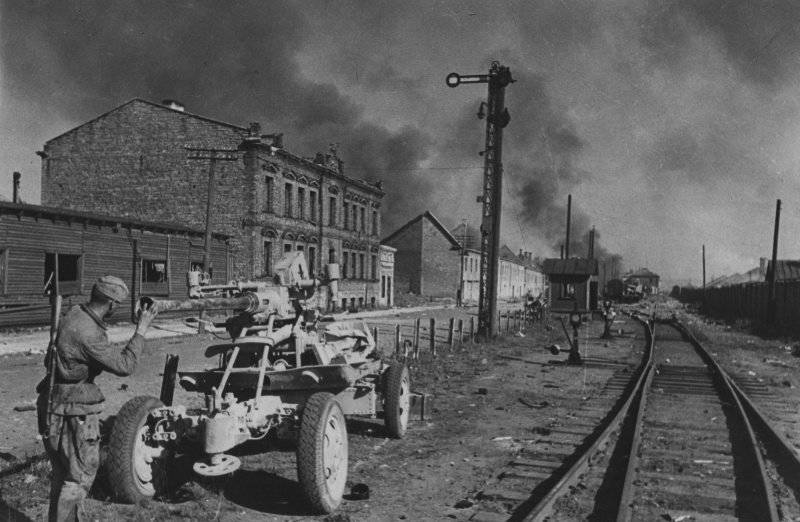
Abandoned by the Germans in the area of the Tallinn commercial port 40-mm anti-aircraft gun "Bofors"
Course of operation
The greatest success was achieved by the troops of the 1 of the Baltic Front under the command of Baghramian. Good intelligence made it possible to identify the enemy’s fire defense system, and it was almost completely suppressed by artillery and aviation training. The strike force front - 4-I shock army and 43-I army, advancing from the area of Bauska, broke through the enemy defenses and in three days advanced to a depth of more than 50 km. The 35 Tank Brigade of the 3 Guards Mechanized Corps and the advanced detachments of General Athanasius Beloborodov’s 43 Army made their way to Baldone and Jelgava. To Riga, there are only about 20 km.
Thus, the Soviet troops broke through to the south-western approaches to Riga and created a threat of encirclement and dissection of the whole Army Group North. For the German command, the organization of strong counterattacks against the troops of the 4 shock and 43 armies became the first priority measure in order to stop them on the approaches to the capital of Latvia. At this time, other troops had to slip out of the surrounding encirclement.
In the meantime, the troops of the 3 and 2 of the Baltic fronts attempted to crack the powerful defenses of the enemy. They advanced slightly, but were able to inflict great losses on the 18 of the German army and shackle its reserves.
The commander of Army Group North, Ferdinand Schörner, fearing the cutting off of the Narva Task Force on the Tallinn direction (6 divisions) from the main forces, asked the High Command for permission to withdraw it. Usually, Hitler’s reaction to such proposals was sharply negative. However, this time such permission was given. The Narva grouping was ordered to be withdrawn to the previously prepared frontiers east of Riga. The German command began to withdraw troops from Estonia, which reduced the front by 300 km.
The systematic withdrawal of the German troops was hampered by the offensive of the Leningrad Front (the Tallinn operation). Govorov's troops struck from the Tartu region. At the same time, part of the front forces, in cooperation with the Baltic Fleet, advanced along the coast. The troops of the 2 shock and 8 armies under the command of generals Ivan Fedyuninsky and Philip Starikov successfully attacked. The 8 Estonian Rifle Corps also participated in the liberation of their homeland. September 20 liberated the city of Rakvere, September September 22 - Tallinn. September 23 Soviet troops occupied Pärnu. By September 26 all of mainland Estonia was liberated from the Nazis. A significant part of the German troops could not break through to the main forces and died or was captured. The Germans lost more than 45 thousand people killed and captured. Combined with the troops of the 3 of the Baltic Front, Govorov's troops engaged in the battles for the liberation of Latvia. Subsequently, the Leningrad Front conducted the Moonsund operation (September 27 - November 24 1944 of the year) to liberate the Mooonzundsky archipelago. Most of the islands were released quickly. Only on the Sõrve peninsula on the island of Saaremaa, the offensive stalled for six weeks. Here the Germans organized resistance on the narrow isthmus of the peninsula. Due to poor organization and lack of ammunition, the Soviet troops for a long time could not break the resistance of the enemy.
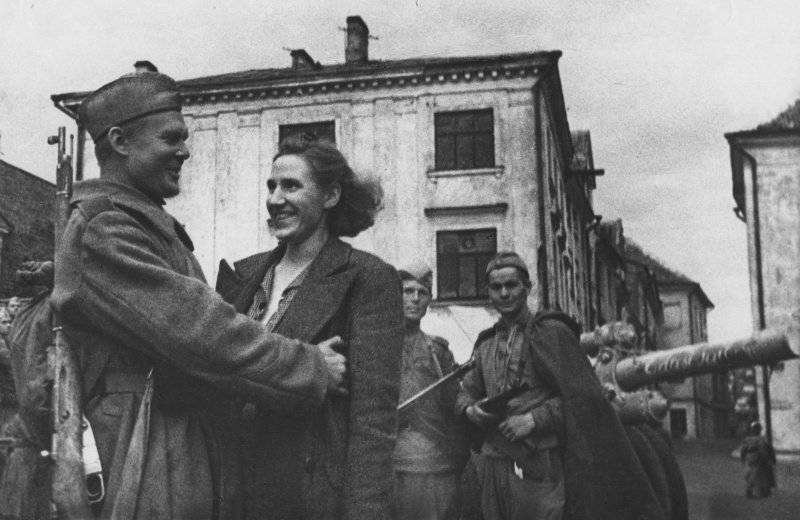
The fighter of the 8 of the Estonian Rifle Corps met his wife on the street of liberated Tallinn. Source: http://waralbum.ru/
Meanwhile, the troops of the Baltic fronts continued to conduct battles in the Riga area (the Riga operation). The German 16, 18, part of the forces of the 3 tank army were replenished with the retreating troops of the Narva group and fiercely fought back at the Sigulda line. The fighting took a particularly stubborn character. Soviet troops had to literally gnaw through the enemy defenses. The Germans went to violent counterattacks and even in places squeezed the Soviet troops. In particular, in the Dobele area, the German forces managed to crush our troops by 5 km at great cost. However, near Riga, the Germans were slowly but surely crowded. 22 September was taken by Baldone. The next day, the German command threw two divisions into the battle, arriving from Estonia. However, the counterstrike was repelled.
Tense battles in the Riga area forced the German command to concentrate its main forces and reserves on this narrow strip (33 divisions, including 4 tank divisions). This allowed temporary retention of Riga and a narrow strip of land along the Gulf of Riga, the last land communication that linked Army Group North to East Prussia.
In this situation, the Soviet Stavka decided to transfer the direction of the main attack of the 1 of the Baltic Front from the Riga to the Klaipeda direction, where the German divisions defended the 7-8. The front command was given the task of regrouping the troops of the four armies with reinforcement from the right flank to the center, in the area of Shaulya. Bagramyan’s troops were to deliver a powerful blow in the western direction, defeat the troops of the 3 tank army and break through to the Baltic coast from Liepaja to the Neman River. The implementation of this operation cut off the troops of Army Group North from Prussia. The 39 Army of the 3 Belorussian Front also participated in this operation. The troops of the 3 and the 2 of the Baltic fronts were to continue to put pressure on the enemy in the Riga direction, holding down the main forces of Army Group North, fighting, not allowing Schöner to regroup.
5 October 1944, the Memel operation began. The troops of the 1 Baltic Front launched an offensive against Memel (Klaipeda). The shock grouping of the front included the forces of the 6 th Guards, 43 th and 5 th Guards Tank armies. They were advancing from the Siauliai area. To the south-west of Siauliai, the 2-I Guards Army delivered a blow.
Soviet troops successfully broke through the enemy defenses and moved west. The 4 shock and 51 armies also joined the attack. The German command did not foresee the possibility of a strike on the Klaipėda direction. The offensive of the 1 Baltic Front on Klaipeda was an unpleasant surprise for the Germans, Schörner was waiting for new strikes in the Riga direction. By the fourth day of the offensive, the depth of the break reached 60-90 km, and the width 200-260 km. Furious counterattacks of the German 3 Tank Army in such conditions did not lead to success.
On October 10, units of the 5 Guards Tank and 51 armies of the generals Vasily Volsky and Jacob Kreyzer reached the sea. Following them on a broad front north and south of Memel to the coast of the Baltic Sea and other connections of the front. The movement of large forces of Army Group North in the Saldus-Priekule area, which tried to break into East Prussia, was stopped as a result of stubborn fighting. Thus, Schörner’s troops lost the last land communications that linked them to Germany.
The siege of Klaipeda-Memel dragged on, and the city was taken only in January 1945 of the year. The Soviet 43 Army was unable to take the walled city in stride. Memel was defended by powerful defenses, fortifications of a serf type with reinforced concrete fortifications such as pillboxes. They were connected by underground passages messages. In addition to the defense of the city attracted coastal and naval artillery. Sea for the defense of Memel added additional troops. On the Tilzitsky direction, the forces of the front left wing and the 39 Army of the 3 Belorussian Front liberated the northern coast of the Nemunas from the enemy and reached the border with East Prussia. Lithuania was liberated from the Germans.
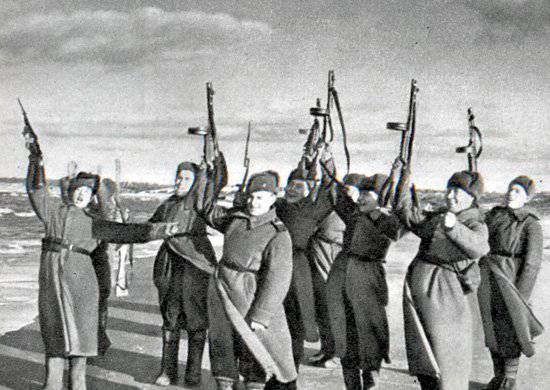
Salute to the soldiers of the Red Army, released on the Baltic coast. Autumn 1944
Taking into account the unfavorable development of the situation in the Klaipeda sector, the German command decided to begin the withdrawal of troops from the Riga area to the territory of the Courland Peninsula. On the night of October 6, the Germans began evacuating troops from the region northeast of Riga. However, the planned withdrawal did not work. Soviet troops relentlessly pursued the enemy. Having broken through the enemy defenses, the troops of 3 and the 2 of the Baltic fronts on October 12 engaged in the battle for the capital of Latvia. The next day, Riga was liberated (the western part of the city was released only on October 15). By October 22, Soviet troops reached the Tukums defense line of the enemy, and blocked the Germans on the Kurland Peninsula. Thus arose the so-called. Kurland boiler. At this, the Riga operation was completed. Most of Latvia was liberated.
It is impossible not to note the large role that Soviet aircraft and the Baltic Fleet played in the operation. Only 14, 15, and 3, the air armies that supported the Baltic fronts from the air, made thousands of sorties during Operation 55. The Baltic Fleet supported the coastal flanks of the ground forces, landed troops, assisted in the liberation of the islands, violated the enemy’s sea communications and carried out important transportation.
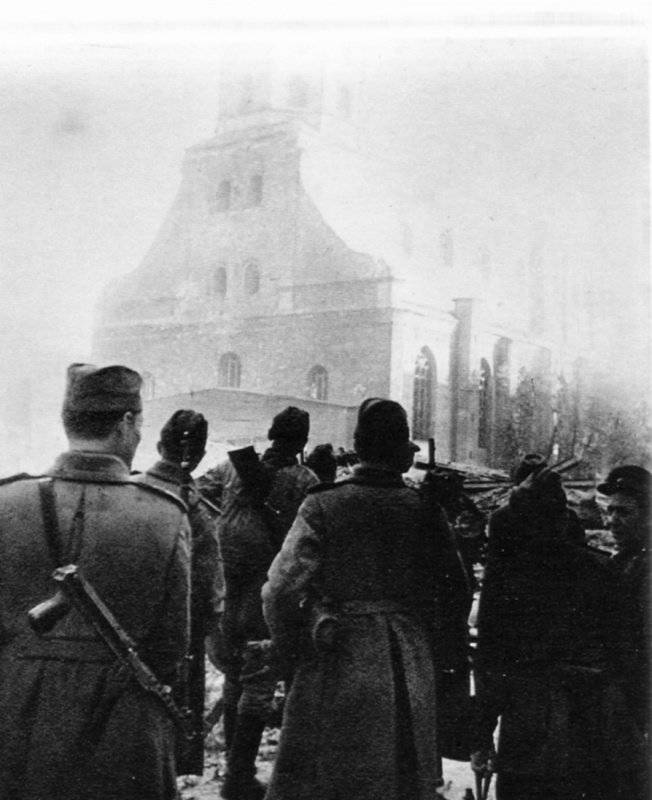
Soviet soldiers in the liberated Riga square
Results
Army Group North suffered a heavy defeat. However, despite heavy losses (from the 59 26 formations were defeated, the 3 divisions were completely destroyed), 33 infantry, armored and motorized divisions remained in its composition. About 500 thousand enemy soldiers and officers, a huge amount of weapons, equipment and ammunition fell into the Courland cauldron. The German Courland group was blocked and pressed to the sea, between Tukums and Liepaja. German troops were doomed. There was no strength to break into East Prussia. There was no sense in waiting outside. Soviet troops quickly developed an attack on Central Europe. Having thrown most of the equipment, supplies, and suffered serious losses in personnel and naval personnel, the group could be transferred to Germany by sea. However, this decision was rejected.
The Soviet command also did not intend to destroy the German group, isolated from the rest of the Wehrmacht troops and unable to influence the battles on the main lines of the final stage of the war, at any cost. The 3 Baltic Front was disbanded. The 1 and 2 Baltic Fronts were given the task of destroying the German grouping. Given the difficult conditions of the area of the Kurland Peninsula (forests and swamps) and the coming winter, which complicated the progress, the destruction of the German grouping was delayed until the end of the war. In addition, the Baltic fronts transferred significant forces to the main lines. Several bitter assaults of the Courland Peninsula did not lead to success. The Germans stood to death, and the Soviet troops were experiencing a shortage of forces, ammunition. As a result, the battles in the Courland cauldron ended only on 15 May 1945.
As a result of the Baltic operation, Estonia, Latvia and Lithuania were liberated from the Germans. Everywhere was restored Soviet power. Only in a small part of Latvia did German troops hold out. The Wehrmacht lost an important strategic foothold and resource base, which it owned for three years. The Baltic Fleet was able to conduct operations on German communications, to cover the coastal communications and flanks of the ground forces from the Gulf of Finland and Riga. Soviet troops with access to the coast of the Baltic Sea were able to deliver flank attacks to German troops in East Prussia.
It should be noted that the Baltic States suffered greatly from the German occupation. During the three years of the Nazi occupation, the population of the Baltic republics suffered enormous calamities. During this time, the Nazis exterminated about 1,4 million local residents and prisoners of war. Greatly destroyed the economy of the region, city and village. There was a lot of work to restore the Baltic states.
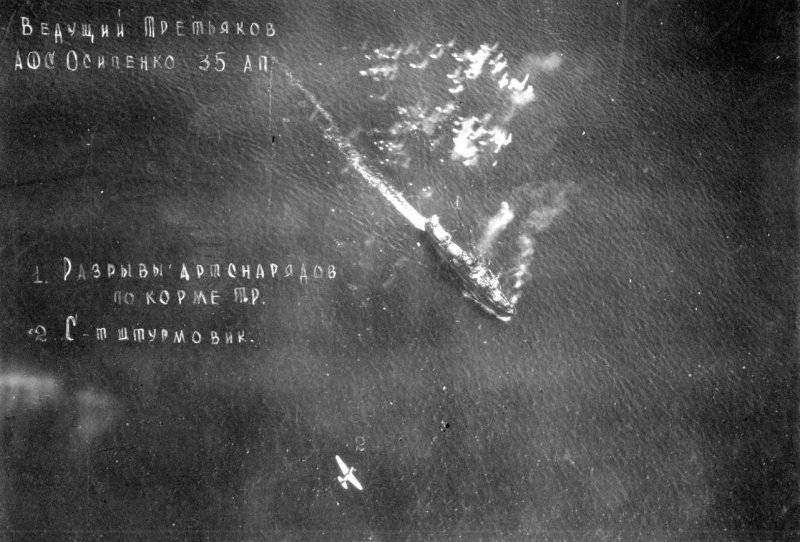
The attack aircraft IL-2 of the Baltic Fleet air force is attacking a German vessel off the coast of East Prussia
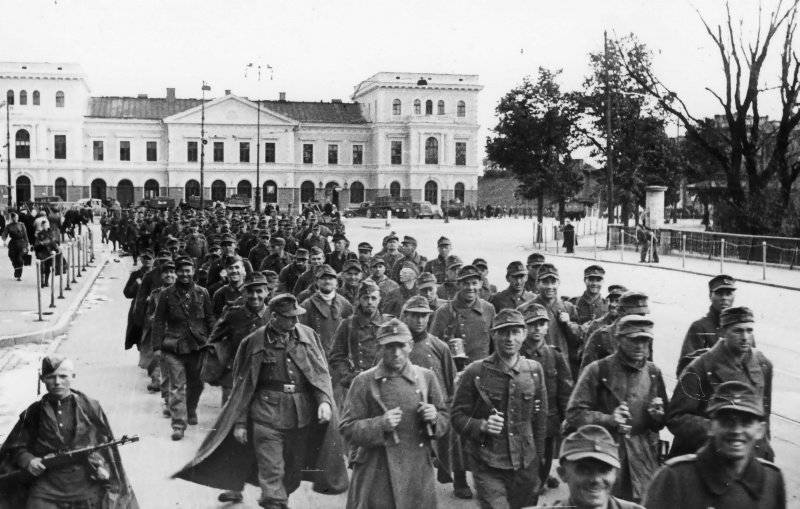
A column of German prisoners of war passes by the Riga Railway Station
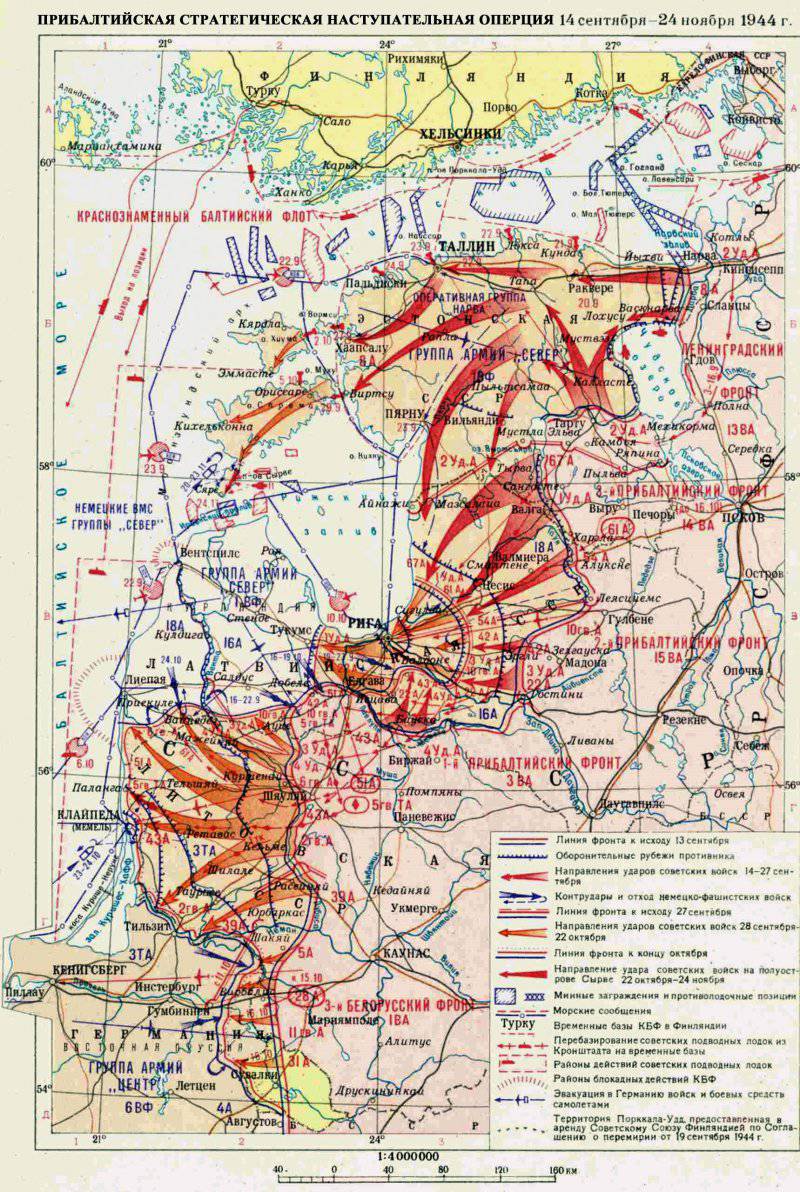
Information